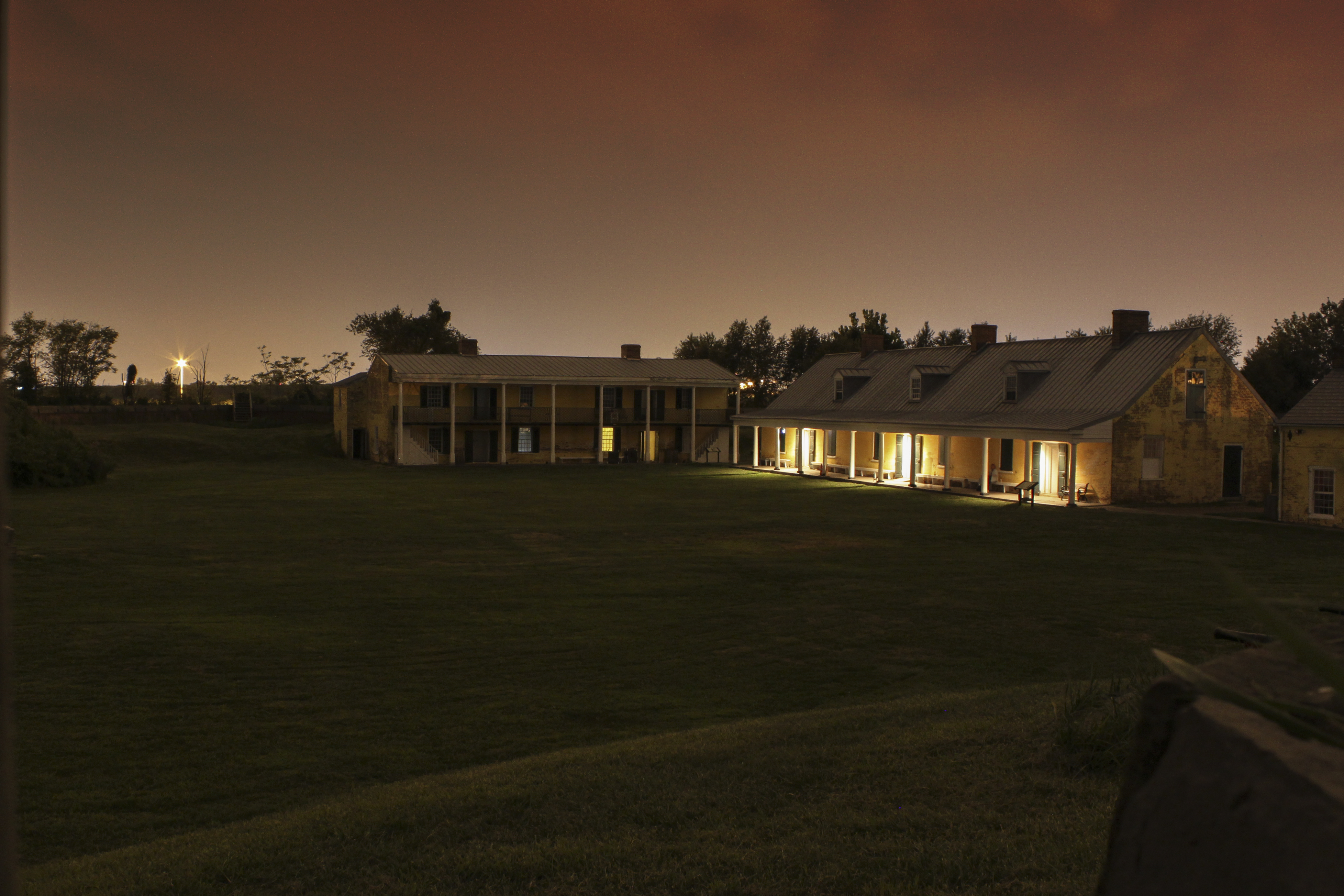Happy hangover-after-Independence Day! In case you haven’t gotten enough America, I’ve got a themed post for you. I hope you like history. And ghosts.
Authentic reenactments

Fort Mifflin, located on “Mud Island” in the Delaware River just south of Philadelphia, is a historic landmark that attracts thousands of school groups, history buffs, and curious tourists each year. Visitors walk one of the only remaining Revolutionary War battlefields and see barracks, hospital grounds, gunpowder rooms, and more. They learn from uniformed guides and reenactors how 200+ men gave their lives in 1777 so that Washington could make his escape, and then how the fort morphed to be used in the Civil War, WWI, WWII, and others.
One of these visitors included a woman who was especially impressed by the casemates, a fortified area that was constructed after 1777 in order to protect soldiers from any future bombardments. The casements are dark and dank, with few windows and so many bugs that they were deemed unsuitable for habitation not long after they were built. But during the Civil War, Fort Mifflin housed people there anyway, using the cave-like rooms as makeshift prisons. Awed by this more atmospheric section of the fort–and the excellent tour guide that presided over it–the visitor went immediately to pass on her compliments to Dori McMunn, then Executive Director of Fort Mifflin on the Delaware. Pleased, McMunn asked her if she could give a description of her guide, so that McMunn could pass along her compliments.
Not wanting to disturb the woman, McMunn merely thanked her and sent her on her way. But as soon as she was gone, McMunn went into the casements to look for the mysterious man. As she had suspected, they were empty–just the moisture on the ceiling and the bugs on the walls. There was no sign of any man there at all.
It wouldn’t be the first time guests would come with enthusiastic compliments about “reenactors” that weren’t part of the staff–including more reports specifically about the Civil War fellow. Fort Mifflin’s caretaker also got word of someone giving tours in the powder room, again with guests offering compliments on “how good he was, and how authentic he looked.” Spoiler alert: There was no one giving tours in the powder room. It seemed that the human tour guides were getting a helping hand.
A second kind of history
Unnerving though these appearances were, it is likely that no one was surprised by them. There is a history of odd things happening around Fort Mifflin, not only to visitors, but to staff and more sanctioned reenactors.

Take a former tour guide, who slept in the officer’s quarters for a few nights. Every morning at 3am sharp, the man was awoken by a rapping on his door. There was no one outside. The guide knew–and probably laid very still in his bed knowing–that 3am happens to be the time which those at the fort used to switch shifts for the next watch.
Or take a story from a reenactor that chose to spend the night in the casements. He fell asleep with a fire in the fireplace and the door locked from the inside. Some time later, he started awake. There was a man in his room, a soldier in Revolutionary War gear, warming himself by the fire. When the reenactor looked twice, the figure was gone. His door was still locked.
He wasn’t the only one to get a surprise. As The Philadelphia Inquirer reported in 2009, “re-enactors who spent the night at the fort reported seeing ‘black, pajama-like shadows’ that spooked them so bad they fired blanks from their period firearms at them. Some saw jiggling doorknobs, a figure peering from an unoccupied room and a hissing shadowy figure. At night’s end, ‘I was picking up trash when I heard the most pleasant woman’s voice in my ear say: ‘Thank you!’’ said re-enactor Ryan Rentschler, who was so unnerved that he ditched the fort sleepover to camp out in a friend’s van.”
To some staff, the occurrences are so common as to almost become old hat. There are numerous accounts of interrupted work, such as the deliberately-closed door to the blacksmith shop repeatedly opening itself on a hot day (staff presumed that 18th-century “Jacob the blacksmith” was feeling stifled). Once a dark figure disappeared into one of the buildings at closing time, only to leap out at the guide that went to hunt them down. Pencils and files spontaneously going missing from office drawers. Windows spring open in the dead of winter. You get the idea.
200-year-old celebrities
On top of all of these are the handful of personalities who are regulars. One is “The Lamplighter,” a man with black hair and a white puffy shirt who drifts through the soldier’s barracks, carrying a long pole with a dim candle at the end to light lamps that disappeared some 200 years ago.

Another is Elizabeth Pratt, or, less kindly, “the Screaming Lady.” Legend has it that she was a wife living in the officer’s quarters that had a nasty falling out with her daughter. Before they could reconcile, the daughter got sick and died. Mad with grief, Elizabeth took her own life shortly thereafter. Unfortunately, her anguish didn’t die with her. There have been reports of her screams echoing from the officer’s quarters, to the point that neighbors have called the police. She is also sometimes seen by children peering out the window of her old room, one hand to her forehead, perhaps hoping to see her daughter among the kids outside.
Perhaps the most sinister ghost is that of the “Faceless Man.” During the Civil War, Private William H. Howe was arrested and held at Fort Mifflin on two charges: desertion and the murder of the officer that went to arrest him. Howe admitted to the desertion, but never to the murder. Nevertheless, it was his fate to become the only prisoner to ever be hanged at Fort Mifflin, a black bag over his head. Supposedly, the grass still refuses to grow at the site where he died, and he is still floats around the casements–a man whose face, even in death, cannot be seen.
“History lives” at Fort Mifflin
Far from trying to quiet these stories, the Fort Mifflin on the Delaware nonprofit organization has chosen to lean into them. And why not? Ghost hunters have helped to raise nearly 40% of the site’s budget. You can go on candlelight ghost tours and even book private overnight stays today. I myself might try to, provided the pandemic ever clears up.
If we’re lucky, we might get a more intimate glimpse into the past than the lovely grounds and educational materials alone can offer. As the Philadelphia Ghost Hunters Alliance’s Lewis B. Gerew II noted, “It’s great to have a piece of history actually interact with you.”
Which war would you most like to interact with a ghost from? Share your preferences in the comments below.
IMAGE CRED: Big thanks to Surfsupusa for Fort Mifflin from above, Larry Lamb for a closer look at the buildings, and Charles Homler for Fort Mifflin at night. Andrik Langfield for the featured image.





0 Comments